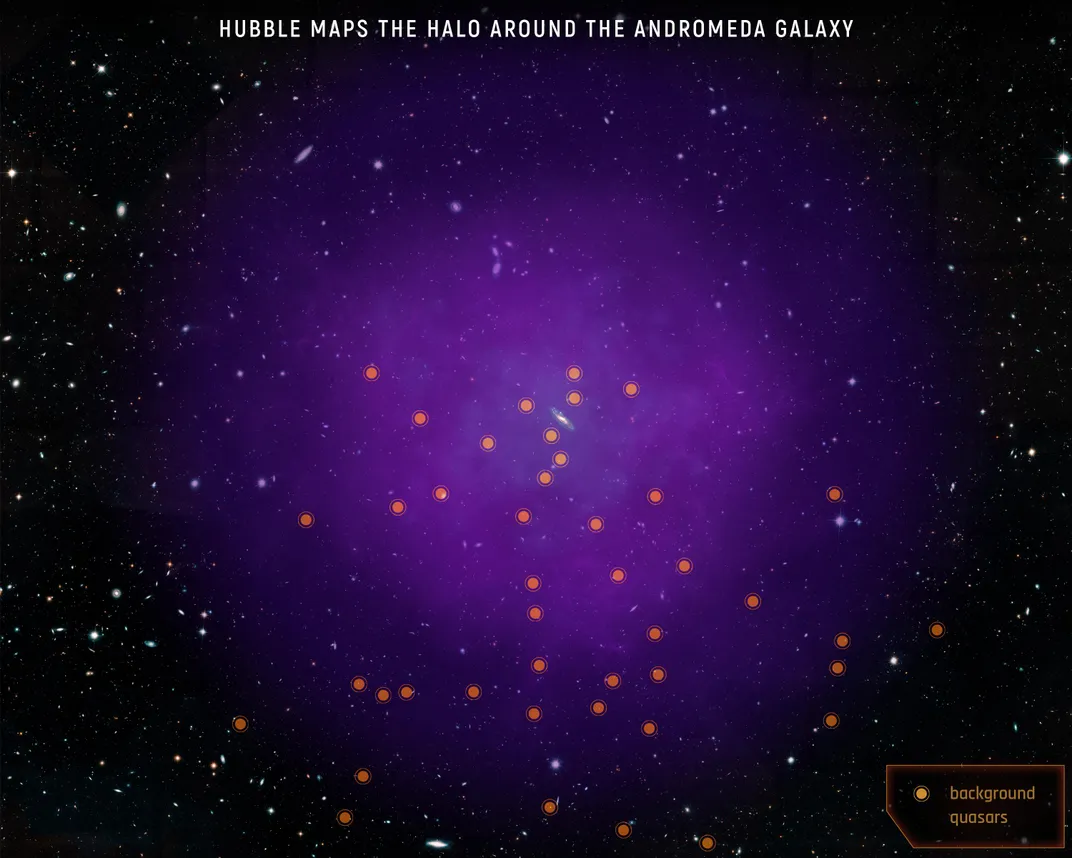Andromeda’s Halo of Gases Is Bumping Up Against Our Own, Scientists Say
Researchers using NASA’s Hubble Space Telescope mapped the gaseous halo that surrounds the Andromeda Galaxy
/https://tf-cmsv2-smithsonianmag-media.s3.amazonaws.com/filer/4c/e3/4ce322d0-670e-4f91-b4f1-28e1b79ba8ea/andromedas_halo_if_we_could_see_it.jpg)
Our Milky Way Galaxy is on a crash course of epic proportions: about four billion years from now, scientists predict it will collide with its neighboring Andromeda Galaxy and form a giant elliptical galaxy, reports Ashley Strickland for CNN.
New data collected by NASA’s Hubble Space Telescope and published in Astrophysical Journal this week, researchers show that the “halos” of the Milky Way and Andromeda galaxies are actually already butting up against one another—an indication of what’s in store in the next billions of years.
A team of scientists, led by University of Notre Dame physicist Nicolas Lehner used Hubble images to create a comprehensive map of the Andromeda Galaxy’s halo, or the large web of gases that extends out and around its spiral of stars, per a NASA statement.
The team found that Andromeda’s halo extends 1.3 million light years in our direction, and as far as 2 million light years in other directions—a bigger area than scientists had previously realized, reports Meghan Bartels for Space.com. Andromeda’s halo reaches nearly half the distance between it and the Milky Way, so the two galaxies’ halos are likely “intermingling,” reports Bartels.
Andromeda, the closest galaxy to our own, is 2.5 million light years away from the Milky Way, which is a relatively short distance on an astronomical scale, reports CNN. It’s close enough that Andromeda itself is visible from Earth as a “cigar-shaped smudge of light high in the autumn sky,” per NASA. Its gaseous halo is invisible to the naked eye, but if viewers on Earth could see it, the halo would appear about three times the width of the Big Dipper.
Andromeda’s halo consists mostly of rarified gas and ionized gas, which makes it very difficult to detect on its own, per the NASA statement. To study and map the halo, scientists identified 43 quasars—huge cores of black holes that emit enormous amounts of light and energy—that are located in the distance behind Andromeda, from Hubble’s perspective. By tracing the light from these quasars as it passed through Andromeda’s halo, the team was able to identify how light was absorbed by its gases, among other things. That information, in turn, helped scientists determine more information about the gaseous halo’s composition, structure and size.

Through this method, known as Project AMIGA (Absorption Map of Ionized Gas in Andromeda), the team found that Andromeda’s halo has a distinctive layered shell structure, with one interior shell nested inside a larger, hotter shell of gas.
“We find the inner shell that extends to about a half million light-years is far more complex and dynamic,” explains Lehner in a Notre Dame statement. “The outer shell is smoother and hotter. This difference is a likely result from the impact of supernova activity in the galaxy’s disk more directly affecting the inner halo.”
“Understanding the huge halos of gas surrounding galaxies is immensely important,” says Samantha Berek, a study co-author and Yale University undergraduate, in the NASA statement. “This reservoir of gas contains fuel for future star formation within the galaxy, as well as outflows from events such as supernovae. It’s full of clues regarding the past and future evolution of the galaxy, and we’re finally able to study it in great detail in our closest galactic neighbor.”
In 2015, Lehner and a team of researchers found that the size of Andromeda’s halo was massive—but this updated map reveals more specifics about the galaxy’s composition and size, they say.
“This is groundbreaking for capturing the complexity of a galaxy halo beyond our own Milky Way,” says Lehner.
/https://tf-cmsv2-smithsonianmag-media.s3.amazonaws.com/accounts/headshot/nora.png)
/https://tf-cmsv2-smithsonianmag-media.s3.amazonaws.com/accounts/headshot/nora.png)